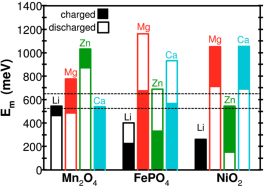Abstract
The diffusion of ions in solid materials plays an important role in many aspects of materials science such as the geological evolution of minerals, materials synthesis, and in device performance across several technologies. For example, the realization of multivalent (MV) batteries, which offer a realistic route to superseding the electrochemical performance of Li-ion batteries, hinges on the discovery of host materials that possess adequate mobility of the MV intercalant to support reasonable charge and discharge times. This has proven especially challenging, motivating the current investigation of ion mobility (Li+, Mg2+, Zn2+, Ca2+, and Al3+) in spinel Mn2O4, olivine FePO4, layered NiO2, and orthorhombic δ-V2O5. In this study, we not only quantitatively assess these structures as candidate cathode materials, but also isolate the chemical and structural descriptors that govern MV diffusion. Our finding that matching the intercalant site preference to the diffusion path topology of the host structure controls mobility more than any other factor leads to practical and implementable guidelines to find fast-diffusing MV ion conductors.
